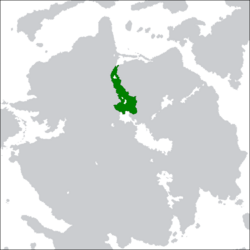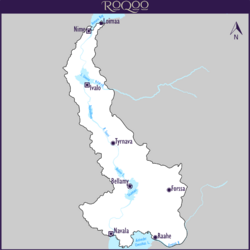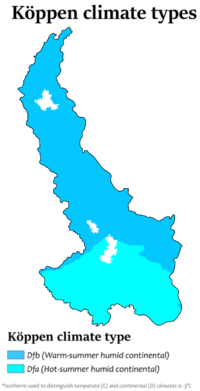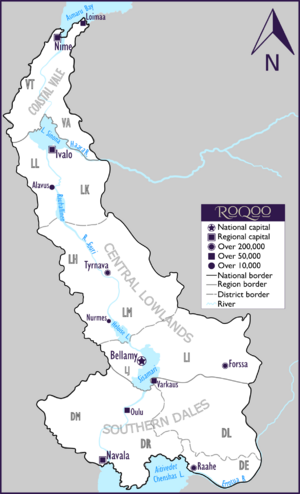Roqoo
This article is incomplete because it is pending further input from participants, or it is a work-in-progress by one author. Please comment on this article's talk page to share your input, comments and questions. Note: To contribute to this article, you may need to seek help from the author(s) of this page. |
Divine Realm of Roqoo Roqoon jumalallinen alue | |
|---|---|
| Motto: Aamu on iltaa viisaampi "The morning is wiser than the evening" | |
| Anthem: Rakas isanmaa "Dear Motherland" | |
 Location of Roqoo in Alharu | |
 Map of Roqoo | |
| Capital |
|
| Largest city | Nime |
| Official languages | Roquanian |
| Recognised national languages | Anglish |
| Ethnic groups |
|
| Religion | Solleu Livot |
| Demonym(s) |
|
| Government | Unitary theocratic elective monarchy |
• Candar | Valtteri Laakso |
• Kansleri | Eliina Makkara |
| Legislature | Hurskaat |
| Area | |
• Land | 325,620 km2 (125,720 sq mi) |
• Water (%) | 2.35% |
| Population | |
• 2022 census | 9,897,654 |
• Density | 30.4/km2 (78.7/sq mi) |
| GDP (nominal) | 2021 estimate |
• Total | 196.3 billion |
• Per capita | 19,843 |
| Gini (2019) | 30.2 medium |
| HDI (2018) | .761 high |
| Currency | Roquan paino (₹) |
| Date format | DD-MMM-YY |
| Driving side | right |
| Internet TLD | .ro |
Roqoo, formally the Divine Realm of Roqoo (Roquanian: Roqoon jumalallinen alue), is a sovereign nation occupying the Avaara valley in northern Alharu, which stretches from the northern arm of Chenshas Lake to the Asmaru Bay, an estuary that flows into the Ygros Sea.
The population of over 9.8 million live predomiiantly in urban areas of the central Avaara valley and lowlands along the banks of the primary river Suuri. The majority of Roqoo's population reside within the major population centers of Nime, Ivalo, and Navala.
The nation's largest city, Nime, is located on the northern coast, a precious natural resource and center of tourism benefiting from its proximity to the sea. As the primary port and largest city, Nime is the de facto capital of the nation and houses many of the key organs of government and international embassies. The cultural and de jure capital, Bellamy, is home to the nation's largest temple and epicenter of the national religion, Solleu Livot, and the official state residence of the Candar, the Raaseporin.
Roqoo is a unitary theocractic elective monarchy ruled by religious head of state, the Candar. While the nation is divided into administrative regions, all are governed by the central government through appointed kirkkoherra (Anglish: "bishops") whom together form the Roquan legislative organ, the Hurskaat (lit. "pious ones").
Roqoo is a developing nation with a high-income economy. Citizens enjoy universal health care and rank high in quality of life and life expectancy. Roqoo has historically remained isolated from major global affairs but has expanded relations externally in recent years, maintaining positive relations and hosting a number of diplomatic missions from many countries across Eurth.
Etymology
The origin of the name Roqoo (pronounced "rue-coo" in Anglish) is largely unknown. Historians theorize the term is an amalgamation of the native Boreaurelian and Azano-Marenesian terms for vast river valley.
Geography
Lying between latitudes 30° and 45° N and longitudes 75° and 60° W, Roqoo is one of the northernmost countries in Alharu. The distance from the southernmost point – on Chenshas Lake – to the northernmost – on Asmaru Bay – is 1,370 kilometers (851 miles).
Roqoo occupies the lowlands and central valley along both banks of the Suuri river, measuring 51.9 km at its narrowest point (east to west) in northern Roqoo near Nime, and just under 500km at its widest point (east to west) just south of Sisameri, its largest lake. Sisameri, formally Maamme sisameri meaning "the inside sea of our land" in Roquan, is the seventh largest in Alharu. The Roquan lowlands contain the most lakes in the country, all naturally formed along the course of the Suuri river; most of the major cities, most notably Bellamy and Ivalo, are located near large lakes.
Most of the territory of Roqoo is less than 100 m (330 ft) above sea level. Much of the geography of Roqoo is a result of plate tectonics, as Roqoo lies on the divergent boundary between the Paran and Herenthem plates, the divergence of which formed the Avaara valley in which Roqoo occupies. The highest point, Korkein Point at 1,119 metres (3,671 ft), lies just southeast of Ivalo near Roqoo's eastern border.
The outer highlands to the east and west, referred to as the Kansan plateau (Kansankatto, lit. "roof of the people"), is sparsely populated and protected by an extensive system of national parks and reserves. Further the central-most lake in Roqoo, Rauhallinen ("tranquil pond") is revered and sacred among worshippers of Solleu Livot, the shores of which are free from urban sprawl and human settlement in an effort to protect the natural beauty and holiness.
Roqoo has a temperate climate that can be described as either humid continental (Dfb and Dfa) or oceanic/maritime (Cfb) although temperatures in the southern region tend to be warmer the closer to Chenshas Lake. The landscape is covered mostly by coniferous forests and fens. Of the total area, 3% is lakes and rivers, and 61% is forest. The forest consists of beeches, hazels, birch, and other species.
Climate
Roqoo has a temperate climate that can be described as either humid continental (Dfb and Dfa) or oceanic/maritime (Cfb). While temperatures do not vary greatly east to west as the country is relatively flat, differences can sometimes be stark between the northern and southern regions, especially closer to Chenshas Lake. The northern coastal region possess the more maritime climate with cooler summers and milder winters, while the southern parts of the country exhibit a more continental climate with warmer summers and harsher winters.
Roqoo has four distinct seasons of near-equal length. Winter starts in early Nellus (equivalent to December), lasting until late Kavun (about end of February). Winter temperatures across northern and central Roqoo average -1 °C (30 °F) and are characterized by bright sunshine, short days, and light snow cover. Severe winter storms occur bringing cold, blustery winds and occasional extreme temperatures of around -20 °C (-4 °F) with heavy snowfalls. Summer starts mid-Avara (early June) lasting until mid-Raavi (late August). Summers bring warm, sunny days with cool evenings and nights. Average summer temperatures for the majority of Roqoo are around 21 °C (70 °F), with rare extremes exceeding 32 °C (90 °F). Spring and autumn generally bring mild weather.
Fauna and flora
Approximately 30,000 species of flora and fauna have been registered in Roqoo. Common species of wildlife include moose, boar, lynx, beaver, hawk, and trout. With 61% of area being covered by forests, mostly comprised of beeches, birch, hazels, hornbeams, pine, and spruce. Several species of flora and fauna are considered national symbols. The Highland Ash and Fire Beech are the national trees and the harfori is the national flower. The wonderhawk is the national bird and the Esoq is the national fish.
Administrative divisions
Roqoo is divided into three primary administrative regions. The regions are further subdivided into "districts" which serve as statistical divisions and are positioned between the administrative regions and municipalities. The "districts" are not administrative divisions nor subjects for any kind of political elections or governing authority but are mainly for statistical use.
The administrative regions are governed by a kirrkoherra, who is appointed by the Candar to represent the region in the national legislature, the Hurskaat. The main responsibilities of the region is to coordinate and manage healthcare, public transportation, environmental planning and protection, and some aspects of secondary education.
Each administrative region contains numerous municipalities, which are somewhat independent from the regions, the only municipalities in Roqoo at this time are the three largest cities. Each of which are represented in the Hurskaat by their own kirroherra. The constitutional capital of Roqoo, Bellamy, is also independently represented in the Hurskaat by the Kansleri. All other cities, towns, and villages in the nation are subordinate to their respective region, despite the ability to tax residents similar to the four large municipalities.
As a unitary state, regions cannot levy taxes and are financed by the central government through block grants and partly through the incorporated municipalities within their borders. Regions do not decide their budgets independently, rather they must use the block grants from the central government for specified purposes, such as for delivering healthcare or improving public transportation resources. Municipalities have limited self-government through a small council appointed by the regional authority (office of the regional kirrkoherra) and while they have the authority to levy taxes, municipal tax rates are capped by the central government at 15%. Municipalities provide two-thirds of public services, but do not maintain national transportation systems, set laws, nor maintain police forces. Law enforcement and law making are sole responsibilities of the central government.
History
Archaeological findings and sources from documented oral history suggest that the lowlands of the Avaara valley and banks along the Suuri river were originally settled by nomadic natives of Thalassa. Broadly, the native ancestors of the modern Roquanian population are descended from a Thalassan subgroup of nomads who arrived in central and northern Alharu as they moved north through the low valleys and vast rivers of Alharu. Archaeological evidence suggests that ancestors of these groups may have been populating north-central Alharu since 2,000 B.C.
The native Alara make up roughly 15% of the realm's contemporary population. The term "Alara" is Roquanian in origin, coined during the first encounters of the Azano-Marenesian peoples to refer to the regional Alharu natives.
The Alara peoples lived simple, riparian hunter-gather lifestyles based on management of ancestral fishing grounds. Fishing, hunting, and primitive farming were their main sources of livelihood. The Alara congregated in "Aiird" groups, which roughly translates to neighborhood, a tribal form of governance focused around a small unit of people anywhere between 20-150 in population. Each "Aiirda" group was composed of households that shared the management and protection of fishing grounds. Elders of each household formed a small council, which led the groups. This system can be characterized as open and highly social—transactions and appeals were almost always conducted in the common clearing, a forum of sorts, and grievances were never allowed to be secreted. While inter-Aiird warfare was common, large scale armed conflicts were rare and warfare was mostly skirmish-like over land or fisheries. The Alara recognized land and wealth as status symbols, working to protect and preserve the land and waters within their territory. This reverence for the land and water was slowly integrated into their cultural philosophy and religion.
Government and Politics
The government of the Divine Realm of Roqoo functions similar to that of an absolute monarchy, with absolute powers granted to the sovereign. In Roqoo, the sovereign head of state holds the title of Candar, a term borrowed from that of the historic leader of the state religion Solleu Livot. The Candar is elected by a council of Livoti viisaat (lit. "elders") for a lifetime appointment. Administrative and legislative functions of the government are largely handled through the Hurskaat (lit. pious ones), a commission of seven appointed individuals, all of whom are primate leaders of the Solleu Livot faith. The Hurskaat consists of the Kansleri and the six kirkkoherra, each appointed by the Candar to five-year terms.
Legislative branch
The Hurskaat meets in the Council House in Nime and is comprised of seven appointed kirkkoherra, chaired by the Kansleri. The Kansleri is the kirkkoherra appointed to represent the capital city of Bellamy while the half of kirkkoherra represent the three other major cities of Roqoo (Nime, Navala, and Ivalo) and the remaining half of the Hurskaat represent the three regions of Roqoo.
The Hurskaat meets year around with recesses taken only during the observed festival weeks. The Hurskaat hold a joint session with the Candar each year in the month of Lira. During this session, the national budget, joint legislative priorities, and term dates are reviewed and discussed to set the agenda for the national priorities for the next year.
Military
Roqoo maintains a standing military organized under the Roquan Defense Force (RDF; Puloustukset). The RDF consists of four distinct branches, the Roquan Army (Maavoimat), Roquan Air Force (Ilmavoimat), Roqoo Coastal Guard (Marivartiosto), and the Home Guard of Roqoo (Kotivartia).
The RDF has nearly 22,500 active duty personnel with over 15,600 in reserve. National mandatory service is current Roquanian law and dictates that all adult Roquanian natives must serve for a minimum standard. This required service can be military or civil service. Military conscription period is 255 or 347 days, while civil service is 404 days. However, conscription law does allow individuals to request unarmed duties which may last eight to thirteen months depending on need.
Any Roquanian citizen who refuses to perform both military or civilian service faces either a monetary penalty or 450 days in prison, minus any days served. The military service may take place in any branch of the Roquan Defense Force, as all train conscripts. Civilian service may take place in the central government or in an accepted non-profit organizations that serves educational, social, or healthcare needs. Service in the national religion, Solleu Livot, does not preclude a citizen from their military or civil service requirements.
Due to the mandatory training and strong reserve programs, the Roquanian conscription makes it possible for over a third of the national population to be called to service in a time of war or armed conflict.
Economy
The economy of Roqoo is driven by the services industry bolstered by high rates of eco-tourism, centered on the coastal resort city, Nime. With the majority of the population performing service or trade-based jobs the government has heavily subsidized mass transportation as a means to facilitate the population moving among the alliridae neighborhoods to meet the needs of the service-based economy.
The three most prominent industries in Roqoo are marine transportation / shipping, tourism, and agriculture.
Primary exports include sugar beet, fish, oats, unprocessed grains, and cranberries. Major imports include textiles, processed grains, fuels, and consumer goods.
Due to Roqoo's high percentage of protected preserves and forests there are several resources that are not adequately or widely exploited, including timeber, natural gas, hydro power, and deposits like silica and taconite iron ore. Minor operations exist to mine rare-eurth metals such as cerium and yttrium which are exported in small quantities for use in production of electronics and glass and for industrial processes.
Demographics
Religion
Language
Education
Cities
Largest cities or towns in Roqoo
2022 census | |||||||||
|---|---|---|---|---|---|---|---|---|---|
| Rank | Region | Pop. | |||||||
 Nime  Ivalo |
1 | Nime | Coastal Vale | 2,113,034 |  Navala  Bellamy | ||||
| 2 | Ivalo | Central Lowlands | 1,665,540 | ||||||
| 3 | Navala | Southern Dales | 1,621,586 | ||||||
| 4 | Bellamy | Central Lowlands | 688,634 | ||||||
| 5 | Forssa | Central Lowlands | 440,597 | ||||||
| 6 | Tyrnava | Central Lowlands | 334,854 | ||||||
| 7 | Raahe | Southern Dales | 295,310 | ||||||
| 8 | Varkaus | Central Lowlands | 162,420 | ||||||
| 9 | Oulu | Southern Dales | 118,124 | ||||||
| 10 | Loimaa | Coastal Vale | 64,071 | ||||||
Culture
The relatively small, egalitarian population prioritizes trade-type training over higher education and reside in multi-generational homes within close-knit, communal neighborhoods, alliridae. Despite the cities being somewhat dense, they are uniquely comprised of dozens of these small, mostly self-contained neighborhoods. The salutation, nyt rizan, meaning blessings of luck, continues to persist throughout Roquan society.
Calendar
The Iltaal calendar, also known as the Roquanian calendar is a solar calendar used in Roqoo. The original Iltaal calendar is one of the oldest documents maintained in the Canfre Vaults and has received little revision since its inception. The calendar consists of 365 days divided into eleven 30-day months and five 7-day festival weeks.
The Iltaal calendar was established by the Solleu Livot kirkkoherra ("archbishop"), Ilta, several hundred years ago as a means to track the mild climate of Roqoo and align Livoti rituals and traditional festivals with that of the Roquanian government.
The customary date format is to write day followed by the two- or three-letter abbreviation depicting the month or festival week, followed by two digit year [DD/MMM/YY]. This format was adopted to clarify differences in dates of the national calendar versus those of the international standard calendar of Eurth.
Months and Festivals
| Name | Type | Celebration | Notes | Season |
|---|---|---|---|---|
| Rakas | State holiday | Leap day | Celebrated between 29th and 30th day of Kavun; non-festival-week holiday | Winter |
| Juhla Niilo | Festival week | Celebration commemorating Niilo, founding father of modern Roqoo | Celebrated immediately between Kavun and Lira; beginning of Spring | Spring |
| Sventa | Festival week | Mid-year holiday celebrating end of wet, Spring season and start of 3 month-long mid-year celebrations | Celebrated mid-year immediately between Heva and Avara. | Spring |
| Lidi | Religious holiday | Holiest day of the year | Celebrated on the 16th day of Renna, 52 day of Mid-year Celebrations; only non-festival-week holiday in Roqoo in standard year | Summer |
| Sato alku | Festival week | Start of harvest, end of Mid-year Celebrations | Celebrated between Sellun and Raavi | Summer |
| Juhla kausi | Festival week | Celebration of seasons | Celebrated between Bellon and Taava | Autumn |
| Tolva kala | Festival week | Winter festival | Celebrated at end of calendar year, immediately between Nellus and Tova | Winter |
- 1. Tova [Tov]
- 2. Kavun [Kav]
- Rakas [Rakas]
- Juhla Niilo [JN]
- 3. Lira [Lir]
- 4. Heva [Hev]
- Sventa [SV]
- 5. Avara [Ava]
- 6. Renna [Ren]
- Lidi [Lidi]
- 7. Sellun [Sel]
- Sato alku [SA]
- 8. Raavi [Raa]
- 9. Bellon [Bel]
- Juhla kausi [JK]
- 10. Taava [Taa]
- 11. Nellus [Nel]
- Talva kala [TK]








